Home > About Us > Sustainability Management > Sustainability Report > Sustainability Report 2014 > Global-Warming Countermeasures
 Global-Warming Countermeasures
Global-Warming Countermeasures
In response to global warming, the Kobe Steel Group promotes rationalization and R&D geared toward reducing energy consumption throughout its operations, while reducing greenhouse gas emissions.
Energy Conservation during Manufacturing Processes
![]()
In fiscal 2013, the Kobe Steel Group used 218PJ of energy (equivalent to 5.62 million kl of crude oil).
Of that total, approximately 95% was used in the Iron & Steel Business, and approximately 4% in Aluminum & Copper.
Kobe Steel continuously strives to reduce energy consumption through such methods as improvements to productivity and fuel management, the introduction of highly efficient equipment, and the recovery of waste heat.
Energy Usage by Business Unit (includes Group companies)
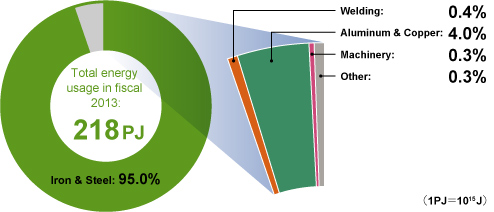
Iron & Steel Business
![]()
-
In fiscal 2013, energy use in the Iron & Steel Business increased by 5.2% year-on-year, while CO2 emissions increased by 5.9%, in part due to an increase in production volume. Compared to the base year (1990), the energy consumption rate per ton of crude steel improved by 16.7%, while the CO2 emissions rate improved by 16.4%.
Aiming for even greater efficiency of its private power station, the Kakogawa Works is in the process of constructing a second high efficiency gas turbine.
At other locations, meticulous efforts are being carried out to increase the efficiency of pumps and fans, improve the operation of heating furnaces, and otherwise reduce loss.
In the future, we will continue to implement energy conservation measures and reduce environmental impact, striving to achieve industry targets described in Nippon Keidanren's Commitment to a Low Carbon Society.
-
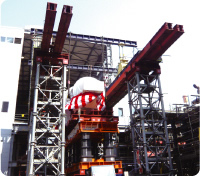
Installation of gas turbine
Iron & Steel Business (Kobe Steel)
Energy Consumption/Energy Consumption Rate Index (Preliminary Calculations)
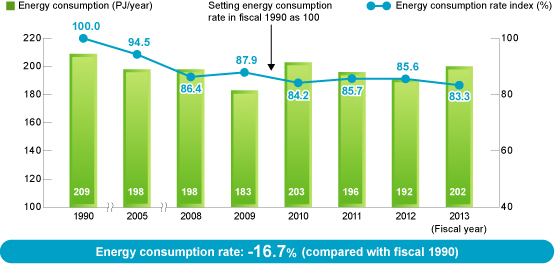
Iron & Steel Business (Kobe Steel)
CO2 Emissions/CO2 Emissions Rate Index (Preliminary Calculations)
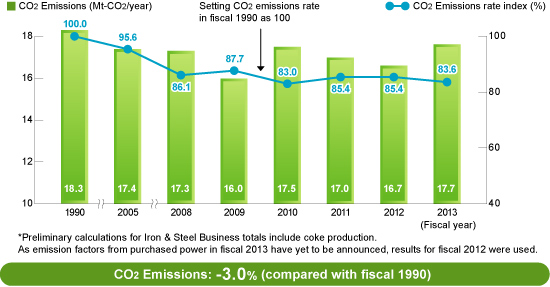
Welding Business
![]()
Through efforts to reduce loss, such as improvements to productivity and optimization of equipment, the Welding Business aims to reduce CO2 emissions. In fiscal 2013, updates were made to the Saijo Plant, including replacement of aging pumps and introduction of higher efficiency boilers.
CO2 emissions were reduced by 27.8% in comparison to 1990, and the CO2 emission rate per ton of product by 24.4%.
Welding Business (Kobe Steel)
CO2 Emissions/CO2 Emissions Rate Index (Preliminary Calculations)
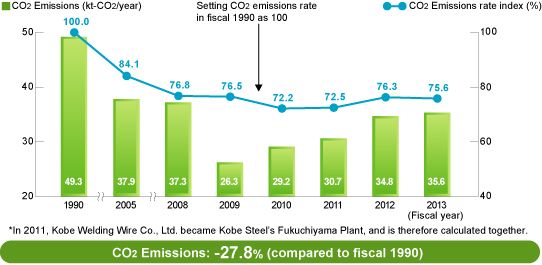
Aluminum & Copper Business
![]()
The Aluminum & Copper Business has been switching from oil-based fuels to natural gas, as well as pursuing equipment intensification and efficiency. In fiscal 2013, heating furnace insulation was improved and boilers were renovated at the Daian Plant. CO2 emissions were reduced by 40% in comparison to fiscal 1995, and the energy consumption rate by 6.4%.
Aluminum & Copper Business (Kobe Steel)
CO2 Emissions/Energy Consumption Rate Index (Preliminary Calculations)
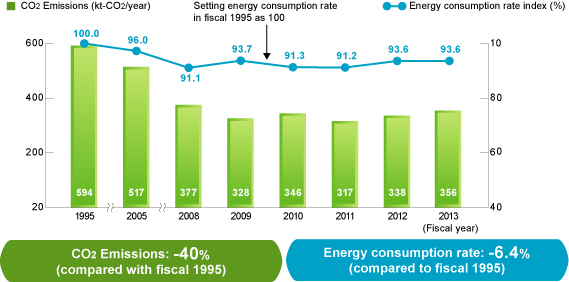
Machinery Business
![]()
As demand for products such as energy-saving compressors, heat pumps and heavy-wall pressure vessels for the oil refining sector increases, the Machinery Business is also striving to increase energy efficiency through optimization of equipment and improvements to productivity. In fiscal 2013, CO2 emissions were improved by 3.5% compared with fiscal 1997, and the CO2 emission rate by 19%.
Machinery Business (Kobe Steel)
CO2 Emissions/CO2 Emissions Rate Index (Preliminary Calculations)
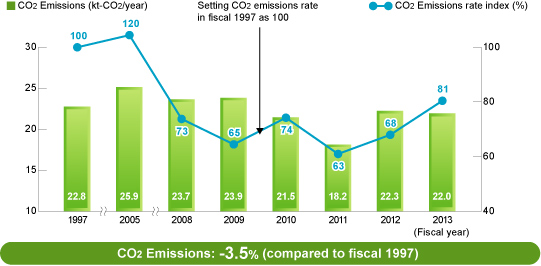
Initiatives in Place at the Kakogawa Works
![]()
An Industry First: Elimination of Idling for Kakogawa Works Diesel Locomotives
![]()
-
Kobelco Logistics, Ltd. has eliminated idling stops for the diesel locomotives thatoperate at the Kakogawa Works. Kobelco Logistics is the first company in the steel industry to achieve this goal.
Eliminating idling has reduced fuel consumption by approximately 25%, CO2 emissions by approximately 1,100 tons, and fuel costs by as much as ¥25 million per year.
Products and materials at the Works are largely transported by locomotive. The Works' on-site rails stretch approximately 62km in total, with around 30 cars in operation at any one time. The cars transport molten iron and steel, finished products, and semi-finished goods 24 hours a day, 365 days a year.
Diesel engines at steelworks generally remain idling even in standby. This leads to unnecessary CO2 emissions. In light of global warming and the rising price of fuel, engine idling poses a significant burden both in environmental and financial terms.
In response to this issue, Kobelco Logistics has made its own improvements to the diesel locomotive control system, introducing a feature to turn off engines when locomotives are stopped. While examples exist of railway companies introducing anti-idling features for hybrid trains, this is the first time that full engine stopping has been made possible for purely diesel-driven cars.
-
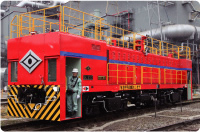
Diesel locomotive with
anti-idling feature
Group Company Initiatives
![]()
Individual Kobe Steel Group companies also strive to reduce energy during manufacturing processes and distribution.
In addition to the initiatives mentioned below, Group companies also implement measures to turn off lights, regulate air-conditioning, and otherwise conserve energy,
Examples of Initiatives
| Company name | Location | Example of initiatives |
|---|---|---|
| Shinko Wire Company, Ltd. | Amagasaki, Hyogo Prefecture | Improved efficiency of induction hardening equipment and other such equipment (contracting with energy service company) |
| Kakogawa, Hyogo Prefecture | Conversion to inverter equipment, upgrade to high-efficiency compressors | |
| Kobe Special Tube Co., Ltd. | Shimonoseki, Yamaguchi Prefecture | Conversion to inverter pumps |
| Introduction of ceramic radiators for heating equipment | ||
| Shinko Kobe Power Inc. | Kobe, Hyogo Prefecture | Improvements to safeguards against degradation of fan functions, reductions to power through adjustments to amount of coolant used |
| Shinko Kenzai, Ltd. | Amagasaki, Hyogo Prefecture | Adjustments to operating pressure of compressors, test installation of LED factory lighting |
| Shinko Bolt, Ltd. | Ichikawa, Chiba Prefecture | Conversion to LED lighting for factory and cafeteria |
| Ceratechno Co., Ltd. | Bizen, Okayama Prefecture | Upgrade to high-efficiency compressors, installation of LED lighting |
| Nippon Koshuha Steel Co., Ltd. | Imizu, Toyama Prefecture | Conversion to LED factory lighting, upgrade to high-efficiency electric motors for steelworks |
| Shinko Kohan Kako Co., Ltd. | Ichikawa, Chiba Prefecture | Installation of high-efficiency compressors |
| Hanshin Yosetsu Kizai Co., Ltd. | Okayama, Okayama Prefecture | Improvements to compressor operation, balancing of electricity demands (through nighttime operation of some equipment) |
| Shinko-North Co., Ltd. | Kasumigaura, Ibaraki Prefecture | Improvements to steam pressure controls |
| Shinko Leadmikk Co., Ltd. | Kitakyushu, Fukuoka Prefecture | Power-saving measures such as application of heat-resistant paint to factory outer walls and improvements to factory ventilation |
| Shinko Aluminum Wire Co., Ltd. | Sakai, Osaka Prefecture | Introduction of inverter for heat-treatment furnace fan |
| Shinko Engineering Co., Ltd. | Ogaki, Gifu Prefecture | Power-saving measures such as minimization of processing times through introduction of simulation technologies |
| Kobelco Shinwa Co., Ltd. | Akashi, Hyogo Prefecture | Introduction of high-efficiency compressors, conversion to LED lighting |
| Kobelco Research Institute, Inc. | Takasago, Hyogo Prefecture | Upgrade to high-efficiency air conditioners |
| PRO-TEC Coating Company | Ohio State, USA | Conversion to high-efficiency lighting |
| Kobelco Spring Wire (Foshan) Co., Ltd | Foshan, Guangdong Province, China | Energy-saving through adjustments to factory production (concentrated production for heat-treatment furnace) |
| Kobelco Welding Asia Pacific Pte. Ltd. | Singapore | Introduction of high-efficiency lighting |
| Kobe Welding of Tangshan Co., Ltd. | Tangshan, Hebei Province, China | Change of fuel source |
| Kobe Welding of Qingdao Co., Ltd. | Qingdao, Shandong Province, China | Introduction of high-efficiency lighting |
| Thai-Kobe Welding Co., Ltd. | Samut Prakan, Thailand | Introduction of inverters for conveyors, blowers, etc. |
| Kobelco Welding of Europe B.V. | Heerlen, The Netherlands | Introduction of high-efficiency lighting |


